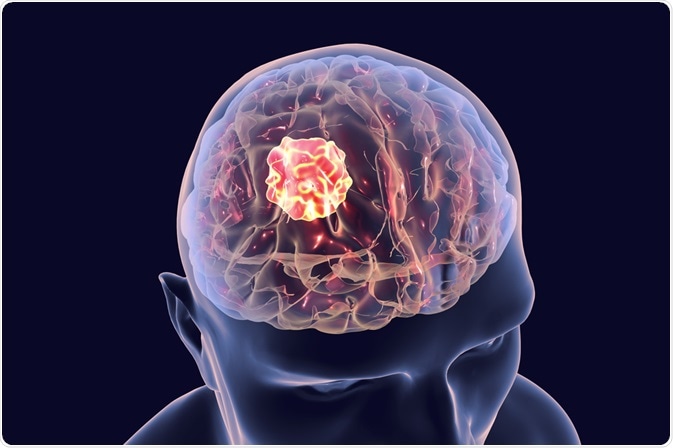Tumors are caused by the uncontrolled growth of cells that destroy healthy tissues surrounding the tumor, causing serious damage to organs.
For tumors either beginning in or spreading to the brain, there are several treatments available, ranging from chemotherapy and radiotherapy to several surgical options.

Image Credit: Kateryna Kon/Shutterstock.com
What is a Brain Tumor?
There are several types of brain tumors, with their severity graded by numbers one to four. Grade one and two (low-grade) tumors are benign (non-cancerous) and grow slowly.
Grade three and four (high-grade) tumors are malignant (cancerous) and grow quickly and are harder to treat.
The symptoms of low-grade tumors are:
- Persistent headaches
- Seizures
- Regular nausea and vomiting
- Drowsiness
- Personality changes
- Weakness and paralysis
- Problems with vision and speech.
The symptoms of high-grade tumors are:
- Headaches that are worse in the morning and when exerting energy
- Seizures
- Regular nausea or vomiting
- Problems with memory
- Personality changes
- Weakness
- Problems with speech and vision.
The symptoms are caused by raised intracranial pressure in the area in which the tumor grows.
What Causes Brain Tumors?
The exact cause of benign brain tumors has not yet been identified, but risk factors are contributing to a person’s chances of developing both cancerous and non-cancerous brain tumors.
These include being over 50 years of age, family history of brain tumors, genetic conditions that predispose a person to brain tumors, and previous radiotherapy treatments.
How Are Brain Tumors Treated?
Depending on whether the brain tumor is benign or malignant, treatment options differ. Additionally, where the tumor is in the brain can change the type of treatment used for the tumor.
Surgery
Surgery is often used to remove benign brain tumors, and they do not often grow back once they have been removed. However, in some cases, tumors can return and become cancerous.
Radiotherapy or chemotherapy can be used even if the tumor is not cancerous, for instance in cases where the brain tumor cannot be fully removed through surgery. The growth rate of the abnormal cells can be controlled through the use of radio- and chemotherapy.
Craniotomy
A craniotomy is the most common type of surgical treatment for brain tumors and is usually done under general anesthetic. A neurosurgeon will cut an opening into the skull to access and remove the tumor.
They can use ultrasonic aspiration, a procedure in which ultrasound waves break up the tumor, which is then gently sucked away from the brain to remove it. The tumor can also be removed by cutting it from the healthy tissue with a scalpel and specially designed scissors.
An awake craniotomy, which numbs the muscles and tissues but keeps the patient awake, is suggested if the tumor is located close to the parts of the brain responsible for speech, movement, and feeling.
Patients are kept awake either for part or the whole of the procedure to allow the surgeon to regularly check the function of a patients’ speech, movement, and feelings.
Patients are asked to speak, move parts of the body, and say what they can feel so the surgeon can be sure they are not damaging important areas of the brain while they are removing a tumor.
Neuroendoscopy
This is a type of keyhole brain surgery. Neuroendoscopy can be used to remove tumors in the ventricles (spaces in the brain filled with fluid), and to remove a build-up of fluid in the brain.
It is carried out with an endoscope, an instrument that is a long tube with a camera and tiny forceps and scissors at the end. The neurosurgeon will make a small hole in the skull and then insert the camera through the hole to see and operate on the tumor.
Transsphenoidal Surgery
This type of surgery is used to remove tumors in the pituitary gland through the nose. An incision will be made in the septum and then the tumor will be with an endoscope and other tools. This type of surgery is not suitable for large pituitary gland tumors.
Carmustine Implants (Glial Wafers)
Surgery can also be used to give chemotherapy directly to the tumor site through implants in the brain. The implants are placed where the tumor has been removed, and they gradually release medication over several weeks.
Radiosurgery
If surgery is not an option, radiosurgery directs small beams of radiation at the cancerous growth to kill the cells.
Radiotherapy
Radiotherapy can be used before or after surgery to apply radiation to cancerous cells through an external machine. It can be used to make other treatments (like chemotherapy and surgery) more effective.
It can cure tumors completely or relieve symptoms if the tumor cannot be cured, called palliative radiotherapy.
Chemotherapy
Chemotherapy stops cancerous cells from growing and spreading. It can cure tumors completely, make other treatments more effective (like radiotherapy and surgery), reduce the chances of the tumor returning, or work as a palliative measure to relieve symptoms.
It can be given intravenously, or through oral tablets. There are different types of chemotherapy medications, and patients can be treated with one or a combination of types of chemotherapy medication.

Image Credit: chainarong06/Shutterstock.com
How Do Doctors Decide On Which Treatment to Use?
The type of treatment a patient receives will depend on several factors. These include:
- The type of brain tumor
- Where it is located
- Whether it has spread to other parts of the body (metastasized)
- The grade of the tumor
- Whether there are mutations in the tumor cells
- The patients’ level of health and fitness.
With certain types of brain tumors, doctors will carry out biomarker tests that will determine which treatment is best for the patient. These tests check for certain proteins like IDH (isocitrate dehydrogenase), 1p/19q, and MGMT (O-6Methylguanine-DNA Methyltransferase).
Summary
Surgery is the most common type of treatment for brain tumors, but medication like chemotherapy and other treatments like radiotherapy can also be effective and used in conjunction with surgical treatment.
The type of treatment a patient is given depends on their overall health, the location and size of the tumor, and whether the cancerous cells have spread to other parts of the body.
Sources
- Cancer Research UK. (2019). Surgery for Brain Tumors. www.cancerresearchuk.org/…/remove-brain-tumour
- Cancer Research UK. (2019). Treatment Decisions. www.cancerresearchuk.org/…/treatment-decisions
- NHS. (2017). Benign Brain Tumour (Non-Cancerous). https://www.nhs.uk/conditions/benign-brain-tumour/
- NHS. (2018). Malignant Brain Tumour (Brain Cancer). https://www.nhs.uk/conditions/malignant-brain-tumour/
- NHS. (2019). Cancer. https://www.nhs.uk/conditions/cancer/
- NICE. (2007) Carmustine Implants and Temozolomide for the Treatment of Newly Diagnosed High-Grade Glioma. www.nice.org.uk/…/carmustine-implants-and-temozolomide-for-the-treatment-of-newly-diagnosed-highgrade-glioma-pdf-373304989
Further Reading
- All Brain Tumor Content
- What is a Brain Tumor?
- Brain Tumor Diagnosis
- Brain Tumor Treatment
- Brain Tumors in Children
Last Updated: Apr 15, 2020

Written by
Lois Zoppi
Lois is a freelance copywriter based in the UK. She graduated from the University of Sussex with a BA in Media Practice, having specialized in screenwriting. She maintains a focus on anxiety disorders and depression and aims to explore other areas of mental health including dissociative disorders such as maladaptive daydreaming.
Source: Read Full Article
